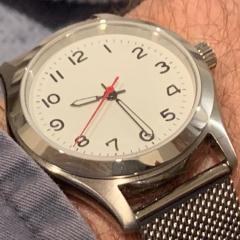Blacksmith, with a love for watches.
-
Recently Browsing
- No registered users viewing this page.
-
Topics
-
Posts
-
I'm no expert, but I'd guess this one is for the bin. Looks like it's been tinkered with by someone armed with a hammer and chisel. When the pallet, escape wheel and balance are all damaged it's beyond repair isn't it? Or a new movement if the watch itself is of value.
-
No need for special tools. Loosen stud screw and just push hairpsring stud out of the hole. Regulator arm is spring circled around the setting housing, insert cutting edge of a safety blade under it, opposit ( 180 degrees) to regu arm itself, and pry half of the circle up, you then see how it all is made at put together. Remove the mobile stud carrier as well, reinstal in proper order, first goes on the stud carrier, second put the regulator arm on top and press it home. Exactly as nev explained above. Trueing inner coils is done when balance complete is seperated from the cock. The part thats bent over itself. 1-Unbend hairspring as much as you can when balance is seperated, just grab the hairspring stud in tweezers , grab hairpsring with another tweezers streighten with strokes as you move the second tweezers away from the stud. 2-Move stud carrier and regulator arm as wide/ apart as they go , to provide max space which comes useful in next step. 3- Fit hairspring stud, into stud carrier hole. 4- Put balance and cock ( when attached together) back on mainplate. 5- You have enough space to grab hairspring in tweezers to shape as you move your tweezers away from stud.
-
Probably more than you need to know in these two vids, but sharing because I found them quite interesting. 🙂
-
And then the problem of the stud holder and regulator which are on the wrong sides of each other: I am baffled as to how this will have happened? They can't re rotated into place, the regulator pins stop the spring stud from moving past. I don't think I can remove the regulator and/or spring stud without a staking set?
-
By nevenbekriev · Posted
Just to inform that this is not a shock protection, just end stone fixed in place by the spring.
-






Recommended Posts
Join the conversation
You can post now and register later. If you have an account, sign in now to post with your account.
Note: Your post will require moderator approval before it will be visible.